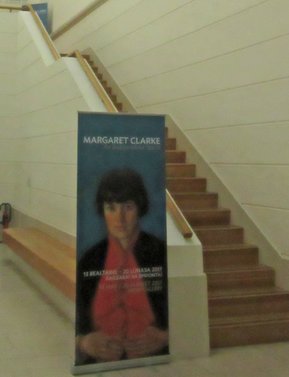 When I was in Dublin, Ireland recently, I had the good fortune to see a small retrospective exhibition of the works of Margret Clarke at the National Gallery of Ireland. Margret Clarke (1884-1961) was a woman artist who achieved success as an artist in the first half of the 20th century. I mention the fact that she was a woman because in those days there was a great deal of prejudice against women and thus for a woman to have achieved success in those days is all the more impressive. Ms. Clarke began her artistic training at Newry Municipal Technical College continuing on to the Dublin Metropolitan School of Art (“DMSA”). Her goal was to become an art teacher and she obtained an art teacher certificate in 1907. However, she won numerous scholarships and prizes thus enabling her to embark on a career as a professional artist. Two paintings in the exhibition by her teacher at the DMSA, Sir William Orpen, show Ms. Clarke as having an intelligent face with lively eyes. These same characteristics appear in her self-portrait. Ms. Clarke achieved success as a portrait painter and her subjects include such ntables as the future Irish prime minister Eamon de Valera. The portrait commissions are traditional and somewhat reminiscent of John Singer Sargent's portrait commissions. Her private works, which cover diverse subjects including family portraits, nude studies and genre paintings, are less conservative. You can see influences of artists such as Cezane and El Greco as well as Asian prints. Still, the works that really spoke to me were Ms. Clarke's drawings, mostly graphite on paper but also charcoal on paper. These drawings were technically superb but at the same time sensitive. Her drawing of her husband, the artist and designer Harry Clarke, done around the time of their marriage in 1914 conveys the emotion that she felt for the sitter bringing him alive. Similarly, her sketches of Julia O'Brien, who worked in the Clarke household in the 1920s have unusual sensitivity. They communicate, which to me is the hallmark of good art. Margret Clarke was only the second woman to become a full time member of the Royal Hiberian Academy in 1927. But while she achieved this degree of success during her lifetime, her reputation faded subsequently. This refelects the fact that the art establishment became co-oped by abstraction during the mid to late 20th century. Figurative work was rejected as passe and unintellectual. Such thinking has now been exposed as close-minded nonsense. Therefore, the National Gallery of Ireland's decision to spotlight the work of an artist who has undeservedly been ignored is to be applauded. |
AuthorRich Wagner is a writer, photographer and artist. Archives
November 2018
Categories
All
|
 RSS Feed
RSS Feed